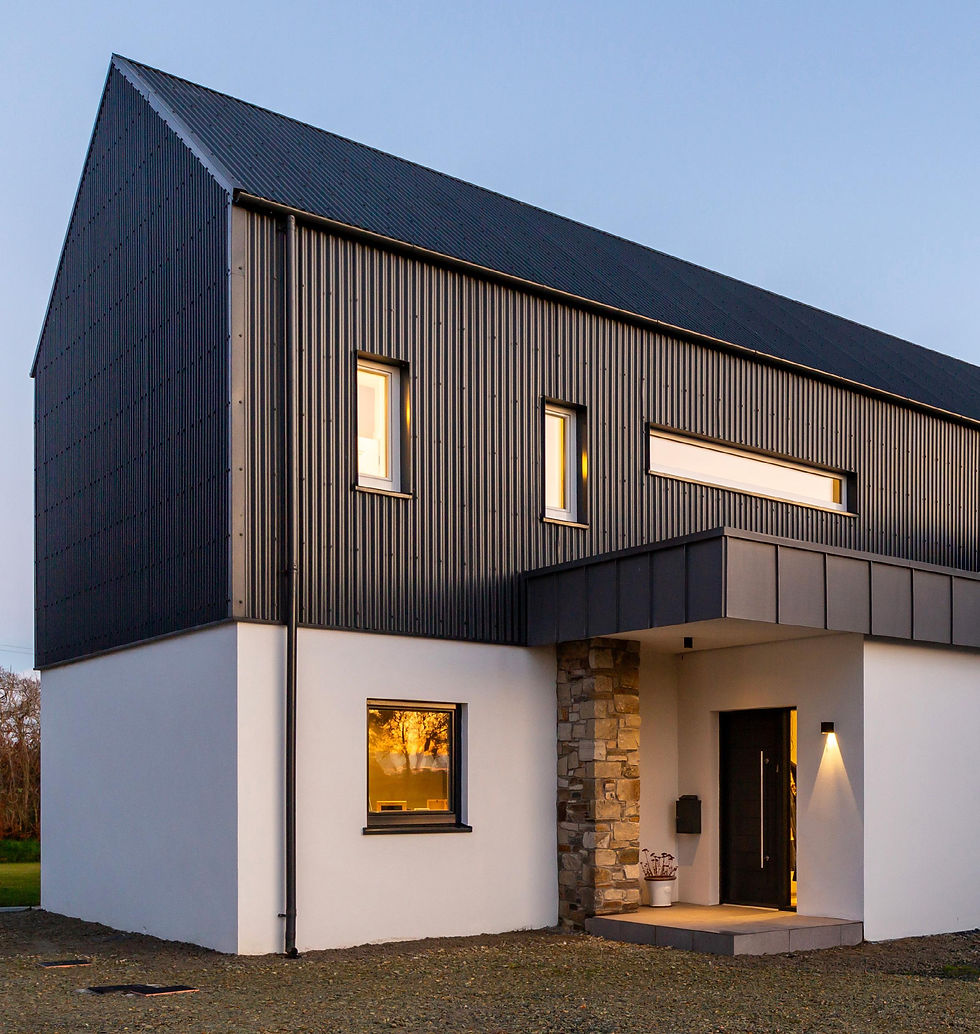The Power of Passive Housing in the UK’s Social Housing Boom
- arqdiary

- Jul 2
- 4 min read
Introduction: Rethinking Affordable Housing
Social housing in the UK is undergoing a quiet but powerful transformation—and passive design is at its heart. Once viewed as a high-end niche or eco-luxury, Passive House (or Passivhaus) is proving its worth where it matters most: in delivering dignified, energy-efficient homes for people who need them most.
As councils ramp up housing programs in response to the crisis, more architects and developers are turning to Passive House standards to tackle energy poverty, improve resident wellbeing, and meet climate goals.
What Is Passive House? (And Why It Works in Social Housing)
Passive House is a rigorous building standard focused on energy efficiency, comfort, and airtightness. Originating in Germany, it’s spreading quickly in the UK’s social sector.
Core principles include:
Super insulation
Airtight construction
Triple-glazed windows
Heat recovery ventilation (MVHR)
Minimal heating demand (typically <15kWh/m²/year)

Why it's perfect for social housing:
✅ Lower energy bills for tenants
✅ Improved indoor air quality
✅ Reduced risk of fuel poverty
✅ Durable, low-maintenance materials
Key Case Studies from the UK
🏘️ Goldsmith Street, Norwich
Architect: Mikhail Riches with Cathy Hawley
100+ homes built to Passive House standards
Winner of the 2019 Stirling Prize
Features: south-facing terraces, communal spaces, MVHR systems
Impact: 70% energy cost savings for residents

🧱 Agar Grove Estate, Camden
Architect: Hawkins\Brown + Mae Architects
UK’s largest Passive House retrofit in progress
Includes new builds and refurbishment
Long-term cost savings for both residents and council

🏢 Passivhaus Plus, Glasgow
Multiple pilot social housing projects by CCG (Scotland) Ltd
Designed for net-zero performance and Passive House compliance
Built fast with prefabricated panels

Why Now? The Social + Political Context
The Passive House movement in UK social housing isn’t emerging in a vacuum—it’s driven by urgent, overlapping pressures:
🔥 Post-Grenfell Building Safety Reforms
After the 2017 Grenfell Tower fire, public scrutiny of the quality and safety of affordable housing intensified. This created a shift away from short-term cost-cutting toward long-term resilience, health, and performance. Passive House, with its airtightness, rigorous oversight, and high-quality materials, aligns with these post-Grenfell values of safety, durability, and transparency.
💷 Energy Poverty & Rising Bills
Energy bills in the UK have spiked dramatically, disproportionately affecting low-income households. Passive homes reduce the need for mechanical heating or cooling, meaning residents can live in thermal comfort year-round while paying a fraction of standard utility costs.
For example, residents in Goldsmith Street pay as little as £150/year for heating, compared to over £1,200/year in conventional homes.
🌍 Net-Zero Commitments by 2050
The UK’s legally binding carbon-neutrality goal by 2050 means every sector—including housing—must decarbonise fast. With the building sector responsible for nearly 40% of CO₂ emissions, Passive House is emerging as a viable strategy for new builds and retrofits.
🏛️ Local Authority Momentum
Cities like Exeter, Camden, and Glasgow are pioneering council-led Passive House developments, both because it saves money in the long term and boosts political capital with visible climate leadership. Passive House has even been embedded into some regional planning frameworks, including:
Exeter City Council’s Passivhaus standard for all new council housing
Camden Council’s adoption of Passive principles for regeneration
In short, Passive House aligns with social justice, climate action, and policy credibility, making it a timely and strategic choice.
Challenges & Criticisms
While the benefits are clear, Passive House still faces practical hurdles, especially in the social housing context.
💰 Higher Upfront Costs
Passive-certified buildings typically cost 5–10% more than standard housing due to enhanced insulation, airtight construction, and high-performance windows.
For local authorities or housing associations on tight budgets, this can deter adoption.
However, studies show that lifetime costs (including energy, maintenance, and health) are significantly lower in Passive House buildings.
🛠️ Skills Shortage
The UK construction industry lacks widespread Passive House-certified tradespeople, particularly in airtightness and MVHR installation.
Mis-installation or cutting corners can compromise performance and certification.
Upskilling through apprenticeships, training programs, and public-private partnerships is vital.
🧾 Misuse of the Term “Passive”
Some developers use “passive” loosely for marketing, referring to general sustainability rather than true Passivhaus-certified performance.
This creates confusion and erodes public trust.
Certification through the Passive House Institute (PHI) or Passivhaus Trust (UK) ensures accountability.
🧱 Retrofit Complexity
Retrofitting to Passive standards (EnerPHit) is more challenging than building new.
Requires deep envelope upgrades, window replacements, and MVHR installation—all while often keeping residents in place.
However, successful models like Agar Grove prove it’s possible and impactful.
🔧 Systemic Policy Gaps
The UK’s national planning and building codes still do not mandate Passive House or equivalent performance metrics.
Voluntary initiatives need to scale into mainstream standards if Passive is to become the default.
Despite these challenges, the benefits for residents and long-term urban resilience are pushing more councils, developers, and young designers to get on board.
The Future of Passive Housing in the UK
With Passive House now included in several local authority frameworks, and housing associations gaining experience with prefab and MMC (Modern Methods of Construction), the model is scaling.
Cities like Exeter, Leeds, and Glasgow are showing how climate policy and social equity can meet under one roof.
Next Steps...
Are you an architecture student or young professional?
Visit a Passive House project in your area
Design a Passive-inspired studio proposal
Learn about Passivhaus certification
Ask: What would a passive campus, clinic, or co-op look like?




Comments